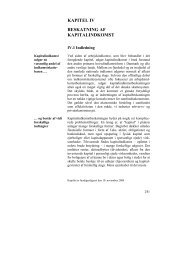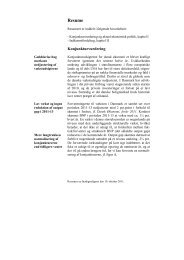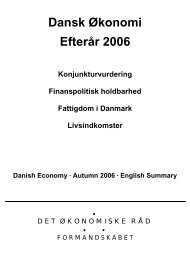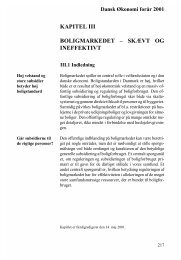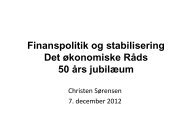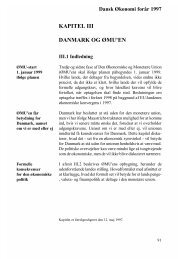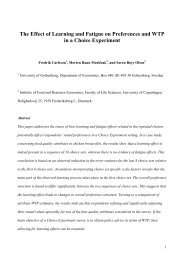- Page 2 and 3:
Det økonomiske RådDet økonomiske
- Page 5:
INDHOLDFremsendelsesskrivelse til R
- Page 8 and 9:
på orlovsordninger mv. Det er mege
- Page 10 and 11:
Formanden for Finansrådet tilslutt
- Page 12 and 13:
til den høje realrente. Han var en
- Page 14 and 15:
Formanden for Funktionærernes og T
- Page 16 and 17:
Miljø- og Energiministeriets repr
- Page 18 and 19:
GældsopbygningenseffekterStrukturr
- Page 20 and 21:
Det økonomiske råderum er imidler
- Page 22 and 23:
De automatiskestabilisatorer......s
- Page 24 and 25:
Afkastet afinfrastrukturOffentlige
- Page 26 and 27:
C0 2 -mål fortransport......kan n
- Page 28 and 29:
Figur 1.1Real BNP-vækstAnm.:Kilde:
- Page 30 and 31:
Figur 1.3Lang realrentePet.Pet.Anm.
- Page 32 and 33:
Figur 1.5Real BNP-vækst, strukture
- Page 34 and 35:
Neutral penge- ogfinanspolitikJapan
- Page 36 and 37:
Fortsat problemermed ledigheden og
- Page 38 and 39:
Stigende inflationHøj arbejdsløsh
- Page 40 and 41:
Figur 1.7Aggregeret offentlig gæld
- Page 42 and 43:
Figur 1.8Den primære saldos og den
- Page 44 and 45:
stramninger, men det ville muligvis
- Page 46 and 47:
Figur 1.10Global lang realrentePet.
- Page 48 and 49:
andet lige falde relativt til udgif
- Page 50 and 51:
Bilagstabel 1.1 Realvækst i udvalg
- Page 53 and 54:
KAPITEL IIDEN INDENLANDSKE KONJUNKT
- Page 56:
Figur II.2Saldoen på betalingsbala
- Page 59 and 60:
Tabel II.3Indenlandsk efterspørgse
- Page 61 and 62:
Figur II.4Boliginvesteringer og rel
- Page 63 and 64:
Renten trækker Investeringerne i 1
- Page 65 and 66:
Figur II.7Lagerkvote i de private b
- Page 67 and 68:
Tabel II.6LønkonkurrenceevneStigni
- Page 69 and 70:
Tabel II.8Import opdelt på underko
- Page 71 and 72:
II.4 Beskæftigelse, løn og priser
- Page 73 and 74:
Tabel 11.11 Antal personer i passiv
- Page 75 and 76:
Privat beskæftigelse Timeproduktiv
- Page 77 and 78:
Stigende nominellerenterRentespænd
- Page 79 and 80:
Tabel 11.14 Den offentlige sektors
- Page 81 and 82:
af saldoen, hvilket bidrager til at
- Page 83 and 84:
...doseringDiskretionærfinanspolit
- Page 85 and 86:
Figur 11.12 Udgiftstryk og BNP-væk
- Page 87 and 88:
Figur 11.14 Strukturel saldo ifølg
- Page 89 and 90:
Finanseffekten måler alene effekte
- Page 91 and 92:
Tabel 11.14 Multiplikatorer i SMEC
- Page 93 and 94:
De 7 magre år og denseneste lempel
- Page 95 and 96:
Tabel 11.15 Betydning for væksten
- Page 97 and 98:
Krav til instrumenterDe offentlige
- Page 99 and 100:
Det økonomiske råderum er imidler
- Page 101 and 102:
Bilagstabel II. 1 Hovedposter på f
- Page 103 and 104:
Lønkvote, i alt 65,9 64,5 64,0 63,
- Page 105 and 106:
a) Den angivne ftxbrugskvoteer bere
- Page 107 and 108:
a) Lønstigningstakt i udlandet fra
- Page 109 and 110:
KAPITEL IIITRANSPORT: ØKONOMI OG M
- Page 111 and 112:
Selvom direkte offentlig regulering
- Page 113 and 114:
Boks III.l Definitioner og afgræns
- Page 115 and 116:
I 1990 blev knap 40 pet. af transpo
- Page 117 and 118:
TransportarbejdePersontransportarbe
- Page 119 and 120:
Figur III.2Relative priser på pers
- Page 121 and 122:
UrbaniseringUrbaniseringsgraden har
- Page 123 and 124:
Figur III.6GodstransportarbejdetMia
- Page 125 and 126:
Trafikarbejdet på vejBelægningsfa
- Page 127 and 128: Kapacitetsudnyttelsenfor lastbiler
- Page 129 and 130: Det internationale aspekt er især
- Page 131 and 132: pet. af produktionsværdien i 1965
- Page 133 and 134: Tabel III.4 Effekt på faktorindsat
- Page 135 and 136: Lav mobilitet i arbejdsstyrken mell
- Page 137 and 138: Globale omkostningerved transportre
- Page 139 and 140: Andre eksterneeffekter:Tab af natur
- Page 141 and 142: LuftforureningLokalRegionalGlobalEn
- Page 143 and 144: Udslip af C0 2Marginale oggennemsni
- Page 145 and 146: Tabel III.8 Gennemsnitlige og margi
- Page 147 and 148: Tabel III.9 Antal personskader ford
- Page 149 and 150: Fordeling afomkostninger påkøret
- Page 151 and 152: Tabel III.13 Samlede omkostninger p
- Page 153 and 154: Maksimalbrændstofafgift.....11 kr.
- Page 155 and 156: Regionale forskelleLavere benzinafg
- Page 157 and 158: På indtægtssiden i de offentlige
- Page 159 and 160: Transportenseksterne fordeleEkstern
- Page 161 and 162: Udgangspunktet for prognosen er fre
- Page 163 and 164: Tabel III.18 Nationalt trafikarbejd
- Page 165 and 166: Prisen på kollektive Siden 1984 er
- Page 167 and 168: Tabel 111.19 Konsekvenser af ændre
- Page 169 and 170: pr. ton C0 2 , jf. Dansk økonomi,
- Page 171 and 172: Sammenfattende kan det konstateres,
- Page 173 and 174: Eksterne effekter ogbenzinprisTekni
- Page 175 and 176: LitteraturlisteBalassa, B. (1961):
- Page 177: Vejdirektoratet (1993): Trafiksikke
- Page 181 and 182: Table 1 : Short-term prospects for
- Page 183 and 184: Still, the room available for activ
- Page 185 and 186: A policy of stabilisation based on
- Page 187 and 188: The public provision of a well-func
- Page 189 and 190: Given that fuel duties are not perf
- Page 191: J. H. Schultz Grafisk A/S



